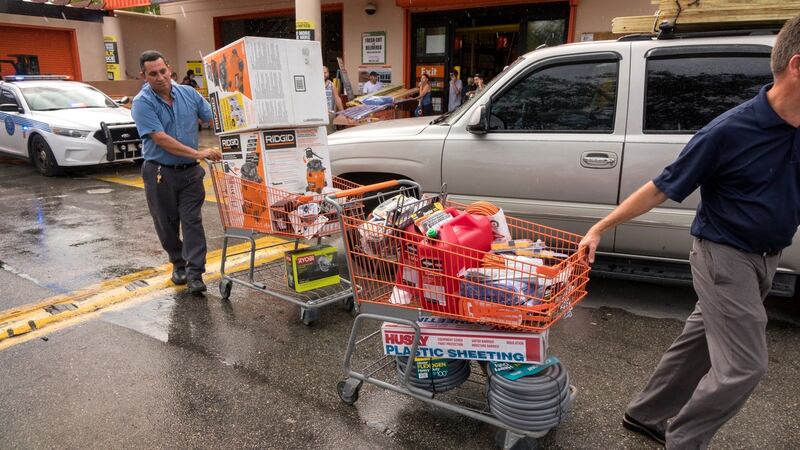This is a tale of two Irmas. First, there's the Hurricane Irma facing Max Borges as he practised his short iron on a Miami Beach golf course just hours before one of the most powerful and deadly storms in modern times was scheduled to make landfall on the US mainland.
Borges, the 51-year-old owner of a PR agency, sat down with his wife and three children on Friday and ran over their prospects as Irma barrelled towards them, leaving a trail of devastation in its wake. Their home in Miami Beach, a wealthy island city that runs along the coast of Miami known for its celebrity residents and art deco buildings, is under mandatory evacuation order.
Yet they had so much going for them, they recognised. Food, water, other essentials to last for days; a solid home raised off the ground to resist storm surge with toughened windows capable of withstanding 155mph winds; even an in-built generator should the electricity go down. They talked, they agreed: they would ride Irma out.
Decision made, Borges went off to practice his short iron. “That was a good one!” he exclaimed, sending the ball soaring off the tee and on to the green.
Ride out storm
There's a second Hurricane Irma descending on southern Florida, the one looming over Louis Diaz and his family in Liberty City, a mere nine miles away in the north of Miami. They too have decided to ride out the storm but where the Borges family is doing it because they can, the Diaz family is doing it because, well, what else can they do?

They have water and food for three days, but no gas in the car if they were to try to leave. When Diaz, 29, went to Home Depot to buy some plywood to shutter the windows, the store had run out. They could never afford hurricane-proof windows, relying, as they do, on his mother’s salary as a transit worker.
“We’re in the inner city here. People don’t want to help folk like us,” he said. “Nobody is leaving Liberty City because there’s nowhere for them to go.”
One mother of all hurricanes, two very different experiences. In Liberty City, the African American neighbourhood that inspired the Oscar-winning movie Moonlight, the chances of escaping Irma’s devastating wrath are all but non-existent. When almost half the residents are below the federal poverty level, generators and storm windows are not an option, let alone a few boards of plywood and a tank of gas.
Most people are taking advantage of the lack of a mandatory evacuation order in their area and staying put. But local organisers fear they are woefully unprepared.
"People in Liberty City are not ready for what's coming," said Valencia Gunder, a community activist helping to set up an emergency response centre for those in distress that will open on Monday morning, in the wake of Irma. "They don't have enough money to pay the rent, and then this happens."
Gunder said an additional problem facing low-income black, Hispanic and Haitian neighbourhoods like Liberty City and Little Havana, the Cuban quarter, was that Miami authorities were so slow to reach them.
“Historically, the city and county and other large institutions do not respond to our communities, so we expect to be without help after Irma for at least three days.”
Storm protection
An unscientific survey of houses in Liberty City suggested that only about one in five were boarded up or showed other signs of storm protection. By contrast, virtually every property in Miami Beach was replete with sandbags, storm shutters and hurricane-resistant glass.
“We got what we got,” was how Michael McGoogan, 55, put it, expressing the sense of resignation that permeates Liberty City.
McGoogan works in a food processing factory and rents out a single room in a boarding house in the neighbourhood, along with eight other people. They each pay $400 a month, not a bad rent for a run-down shack, but when they talked to their landlord about the coming storm he told them they had to look after themselves.
They clubbed together, scoured local stores and managed to cadge a couple of boards of plywood which the used to shutter the two windows in the front of the house. That left eight other windows exposed on the sides and back.
“I know what I need to do,” McGoogan said. “If the windows start smashing, I’m going to put my mattress up against them and if that don’t work, I’m going to hide in the bathroom.”

As Irma veers in its path, reserving its most terrifying force for the Florida Keys and potentially the west coast of Florida up to Tampa, Miami may be spared some of the worst of the disaster. But this is such a massive storm, its radius of destruction so wide, that it still has the potential to shatter windows and tear off roofs throughout southern Florida.
Thousands of people have heeded the evacuation orders, with local TV stations bombarding those in the evacuation zones with warnings to get away. In Miami-Dade, the county that covers the city, more than 20,000 people were in shelters on Saturday, many of which had closed having reached capacity.
Many others had fled the city, in a decision that many will come to regret. Some travelled west towards Naples, unwittingly moving right into the path of the storm.
Pre-apocalyptic feel
Miami Beach and surrounding islands were largely evacuated, giving an area normally heaving with tourists and sun worshippers an eery pre-apocalyptic feel. The area is so low-lying that it experiences flooding even at regular high tides, let alone major hurricanes, and the scale of this storm may overwhelm the best-laid plans.
“Pray for Miami Beach” the owner of Mango’s Tropical Bar had spray painted on the boards that now shuttered the restaurant on Ocean Drive, the celebrated art deco strip in South Beach.
Nearby Fishers Island, that boasts the most expensive zip code in the US (median home price $6m) had emptied out. At the ferry port a sole white Daimler was parked ready to whisk the last fleeing resident away.
But Borges was not the only one who had decided to take a risk and stay. On the beach, just hours from Irma's unwelcome arrival, Matthew Delafe, 25, was taking advantage of the sudden absence of people to exercise on the dip bars on the beach on Ocean Drive.
“I’ve never seen it this empty,” he said. “There are always 300lb guys on these bars, so I’m finally taking my chance.”
Delafe lives with his parents in Broward County further north and inland. They too have a generator, and his father landscaped their property to create a hill on which their purpose-built house sits, raised up above any flood waters from the Everglades.
“So I’m not that scared,” he said, performing another dip. “I’m planning to give Irma the finger.”
Guardian Service



















